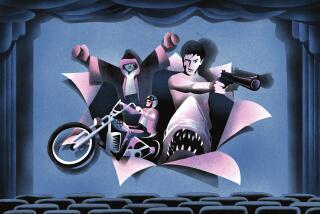Television review: ‘Roger Ebert Presents At the Movies’
- Share via
It is impossible to overstate the influence of Roger Ebert, his late sparring partner Gene Siskel and the Chicago show they began on PBS that would become “Sneak Previews” and later “Siskel & Ebert at the Movies.” Growing out of the natural rivalry between two Chicago dailies — Siskel worked for the Tribune, Ebert for the Sun-Times — their weekly face-offs both demystified and popularized film criticism. That they very often disagreed was a weekly lesson in subjectivity. It made intelligent film criticism part of the public discourse, along with their signature “thumbs up/thumbs down.”
After Siskel died in 1999, Ebert teamed up with Richard Roeper until, in 2006, he lost part of his jaw to thyroid cancer, rendering him unable to speak. Friday night Ebert returned to television with the series “Roger Ebert Presents At the Movies.” (It airs in Los Angeles on KCET and KLCS; check local listings for air dates.) Though it’s Associated Press’ Christy Lemire and Ignatiy Vishnevetsky, a critic for mubi.com, occupying the balcony seats Ebert and Siskel made famous, the big news of the show was Ebert’s return and his new prosthetic chin.
As he detailed on his blog, Ebert has been fitted with a new chin to make him look more like his former self, which he did, albeit very briefly, in a segment toward the end of the show called “In Roger’s Office.” The critic, who still cannot speak, was shown at his computer writing a glowing review of the animated film “My Dog Tulip,” which was then voiced by director Werner Herzog. Herzog did a fine Roger Ebert, and even a fairly nifty prosthetic chin pales a bit when compared with the ability to whistle up Herzog as your voice-over.
Still, it was rather anticlimactic, the Ebert appearance, and the question becomes: Is there still a place for a television show featuring two film critics sitting around talking?
“At the Movies” did not fare very well in recent incarnations — the most recent pairing, of the Chicago Tribune’s Michael Phillips and the New York Times A.O. Scott, was canceled after one season. And Lemire and Vishnevetsky appeared quite nervous and stiff. By the second half they were a bit more comfortable, ad-libbing with some heat and humor as it became clear that they were not going to agree on anything. “No Strings Attached,” “The Company Men,” “The Way Back,” “The Green Hornet” — Lemire hated them while Vishnevetsky continually disagreed. Each had fine, solid arguments for their thumb action but neither were terribly persuasive or compelling.
That will improve, no doubt, but it’s difficult to argue that we need another incarnation of “At the Movies.”
This pairing does pit old journalism (the AP) against new (mubi.com), young (Vishnevetsky is but 24) against established (Lemire’s been writing film reviews for 12 years) but it’s difficult to see what that will bring to the conversation. In the end, it’s two critics sitting around talking, and whereas Siskel and Ebert had great chemistry and novelty on their side, these two have only chemistry. This puts a lot of pressure on them to become performers, which is a dangerous second job for a film critic.
More to Read
The complete guide to home viewing
Get Screen Gab for everything about the TV shows and streaming movies everyone’s talking about.
You may occasionally receive promotional content from the Los Angeles Times.







